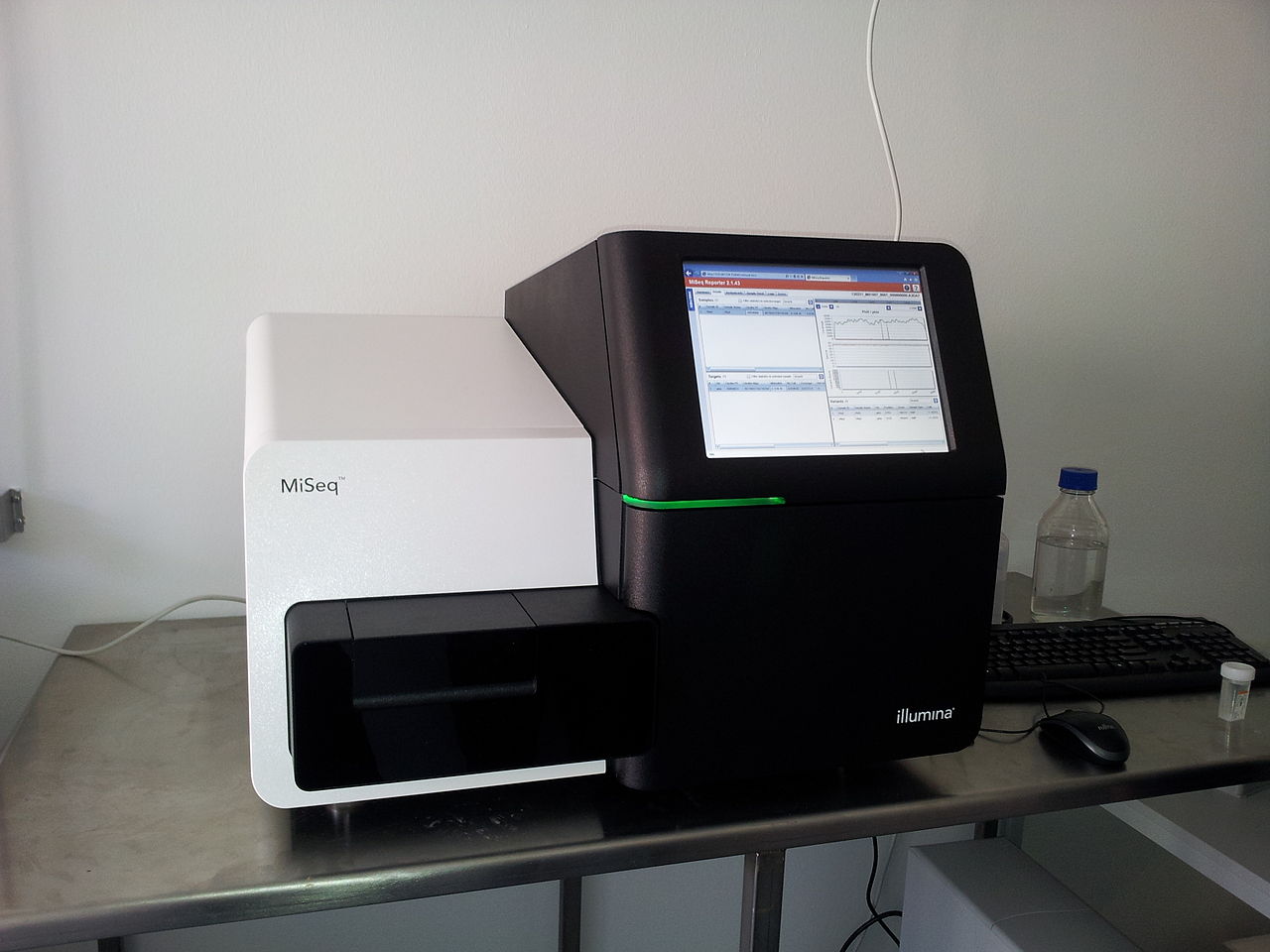Genotyping and Sequencing
Genotyping, that is the use of genetic make-up (i.e. DNA patterns) for classifying pathogens, has been used for characterising pathogens and decoding outbreaks for the past few decades. Techniques such as restriction fragment length polymorphism (RFLP), variable number of tandem repeats (VNTR) sizing, spoligotyping and pulsed-field gel electrophoresis (PFGE) have been used to type a variety of different bacteria and identify their relatedness. Multiplex PCR has been used to distinguish pathogens using well-known “marker genes”.
All of these techniques use known patterns in the genetic code of target organisms as a basis for classifying them as types, sampling small parts of the pathogen’s genome for classification.
The direct sequencing of pathogens’ genomes aims to gain higher resolution in genotyping by sequencing (i.e. “reading”) the genomic sequence itself of the pathogen being examined. Current technologies do not allow the complete genome of a pathogen to be read, but rather generate fragments (called “reads”) of genetic information that are later used to infer the genome (or, in the case of targetted sequencing, parts of the genome). From this reconstructed genome, bioinformatic methods can then genotype the pathogen with a higher resolution than previous methods.

Sequencing Technologies
The first widely used sequencing technology was Sanger sequencing which is able to sequence some hundreds of base pairs downstream of a given primer match. For the most part Sanger sequencing is restricted to sequencing one or a small number of genes. In this regard it can be consider a “targeted sequencing” technology. Sanger sequencing produces outputs known as chromatograms of which typically a middle section is useable to “call” DNA bases. In other words, the output of Sanger sequencing is a small number of high quality sequencing “reads”.
Modern whole genome sequencing (WGS) relies on high throughput techniques that can produce hundreds of thousands or millions of sequencing reads spanning a whole genome. The most commonly used sequencing technologies are those from Illumina and Oxford Nanopore, although other platforms (e.g. from MGI/BGI, Pacific Biosciences and IonTorrent) do exist.
Illumina sequencing
Illumina sequencing, sometimes simply known as “Next Generation Sequencing”, produces reads of 75 to 300 base pairs. These reads have highest sequencing quality near the start of a read with quality dropping off towards the end. Typical individual base calls have 99.9% accuracy. Because sequencing library preparation involves generating DNA fragments of approximately fixed size, each individual DNA fragment yields pairs of reads, one from either end of the fragment, with a known “insert size” between them.

Illumina sequencers range in size from desktop devices (like the iSeq, MiSeq and NextSeq) to refrigerator sized units (the NovaSeq range). Run times for sequencing runs range from 14 hours (for the iSeq 75 base pair reads) to 24 hours or more.
Oxford Nanopore sequencing
Oxford Nanopore sequencing is an example of “Third Generation” sequencing that produces reads of hundreds to tens of thousands of base pairs by reading an electrical signal while moving a DNA (or RNA) molecule through a protein “pore”. Like Illumina sequencing, sequencing of multiple reads happens simultaneously in a massively parallel process. Unlike in Illumina sequencing, single reads are produced from each journey of a DNA molecule through a pore and base quality is not related to the position of the base in the read.

Oxford Nanopore produces portable (MinION) and benchtop (GridION and PromethION) sequencers. As sequencing output can be examined during the sequencing run, run time of Oxford Nanopore devices is somewhat variable, with a maximum of 72 hours but a minimum of considerably less, depending on the application. Per base sequencing quality ranges from 95% (on older R9.4 flow cells) to 99% (on R10 flow cells). Homopolymers (i.e. stretches of the same DNA base) pose a particular challenge for Nanopore sequencing and thus false insertions or deletions are common.
From Sequence to Genotype
As noted above, sequencing produces “sequencing reads” which are combined to reproduce the genome of the organism being sequenced. This combination typically involves some combination of aligning using a known “reference genome” and computation of overlaps between reads to generate larger stretches of contiguous DNA (contigs). The resulting combined reads can be used for genotyping either by single nucleotide variants, by identifying patterns of known alleles or by other methods such as k-mer comparison or mash distance.
Single Nucleotide Variants and Indels
Single nucleotide variants (SNVs) are individually bases that differ between sequencing reads and a comparison genome (typically a “reference genome” of the organism being studied). The alignment of several (tens to hundreds) of reads against this comparison genome increases the confidence that the SNV identified is a true SNV and not a sequencing error. In addition to single bases changes, inserted or deleted bases (indels) can sometimes, but more rarely, be used for genotyping an organism.
When the placement of a nucleotide SNV in the context of a gene sequencing is known (because of annotation of postions of genes on a genome), the SNVs impact on the amino acid of a protein can be inferred. SNVs can either be synonymous (if they would not change the amino acid) or non-synoymous (if they would change the amino acid or result in a stop codon).
When taken together, the pattern of SNVs in a genome results in a genotype that in turn can be compared to other known genotypes to infer the relatedness of pathogen isolates, in a process known as phylogenetics.

Alleles and Multilocus Sequence Typing
Genotyping by SNVs always involves the use of a comparison (reference) genome. In some organisms (e.g. SARS-CoV-2 or M. tuberculosis) this is the preferred approach and much knowledge has been gained on the significance of SNVs for, for example, immune evasion or antibiotic resistance. This approach assumes, however, the existence of an appropriate comparison genome and also that the genome of the isolate being studied contains all the genetic material of interest.
In many bacteria, species diversity through recombination and the changing complement of mobile genetic elements (e.g. plasmids) present in the pathogen increases the risk of errors in SNV identification or makes the choice of a reference genome difficult to impossible. Genotyping is still possible for these organisms by identifying the specific alleles present at particular genomic loci. This approach is called multilocus sequence typing.
As an illustration, consider meningococcus (N. meningitidis). In 1998 Martin Maiden and colleagues published a proposal to use the genomic sequences of the abcZ, adk, aroE, gdh, pdhC and pgm genes for genotyping isolates of meningococcus (fumC was added in a subsequent publication). The genes chosen are so-called “housekeeping genes” conserved across most strains of the organism. Each known allele (i.e. sequence) for each gene is given a number, and isolates are typed by matching their sequence to these known alleles. The collection of known alleles and their numbers is known as a MLST scheme. A particular known combination of allele numbers identifies as sequence. So long as isolates are genotyped using the same scheme, they can be compared to one another. The number of loci with different alleles also gives some indication of the degree of difference between isolates, although it is import to note that nothing can be inferred about the degree of difference that an allele mismatch represents. Allele 1 is not necessarily more similar to allele 2 than it is to allele 5.

Whole genome sequencing has allowed MLST to expand beyond to core genome MLST (cgMLST) and whole genome MLST (wgMLST) with correspondingly large numbers of loci. The PubMLST website stores MLST schemes for over 100 organisms and over 35 million different alleles. By contrast to the seven gene scheme noted above, the cgMLST scheme for meningococcus available at PubMLST is based on over 1000 loci. Such large cgMLST schemes allow fine resolution typing of pathogens.
K-mers, MinHash, Mash and more
While SNV typing and allele-based MSLT are the most common methods currently used for genotyping pathogens, other sequence comparison techniques are possible and in use either in research or in specialised contexts. One such technique involves computing the set of sequences of length k from a genome. These (typically short) sequences are known as k-mers and the number of k-mers that two genome sequences have in common can be used as a measure of the genetic distance between the two sequences.
Yet other string comparison techniques have been applied to genomic sequences, including the use of the MinHash metric in an approach called Mash distance. As with k-mers, this technique allows rapid estimation of the degree of difference between sequences.
While not currently used for genotyping, these techniques are mentioned because of their importance in emerging bioinformatic techniques for e.g. species or genus identification and rapid discovery of similar sequences.
From Genotype to Outbreak Cluster
The identification of genotypes is seldom, in itself, the end goal of sequencing. As described in the previous sub-module, sequencing and genotype information might be used to infer changes in the circulating population of pathogens, or for outbreak investigation. For these use cases, measures of similarity can be applied to the genotypes of isolates to identify clusters.
Lineage names, sequence types or positions in clusters are all types of information that can be derived from pathogen sequencing. Methods for computing such information and the appropriate analysis tools and databases to use in this computation form the basis of the field of pathogen bioinformatics for public health.
Questions for Discussion
You receive sequences from two isolates of SARS-CoV-2 that appear to be genetically identical.
- Are these isolates part of a single outbreak (i.e. a single transmission chain, where one case might have infected the other)?
- What other information could help to answer this question?
- If part of the genome sequence could not be recovered due to low sample quality, would you expect the isolates to look more, or less, similar? Why?